A New Sanga Revitalizes an Aging Shingon Temple
Written by: Rev. Kosho Finch
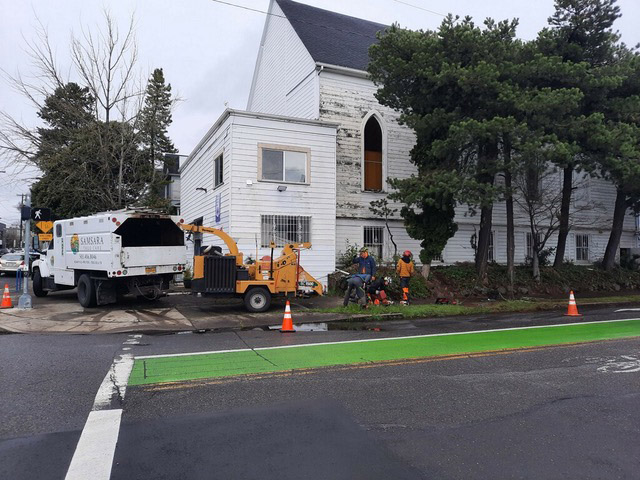
Side view of temple, and spring 2023 tree trimming.
Photos: Courtesy of Henjyoji Shingon Buddhist Temple
Members of Henjyoji Shingon Buddhist Temple in Portland are slowly rebuilding the physical structure of their temple as resources are available, while broadening outreach to a wider audience. Bringing a temple back from the brink of extinction means pouring energy into spiritual practice, as well as into the physical rebuilding.
In 2022 temple volunteers replaced part of the building’s foundation, fixing an issue discovered in the process of giving the bathrooms a facelift. That project could not have been completed without the sometimes-backbreaking efforts of members, who excavated one side of the building.
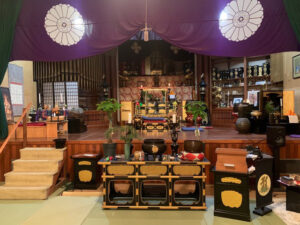
View of naijin, inner altar space.
Later in 2022, the front siding was replaced to address damage from Portland’s 1962 Columbus Day storm, which was another unexpected need uncovered by heavy winter rains. With all the improvements we have made, many more are on the horizon.
When people inquire about visiting the temple, I often ask them, “Have you ever seen the series This Old House?” and explain that we are still very much on episode one. Then when people visit and look around, they inevitably ask, “When will the repairs be completed?”
An answer is hard to come by. With a building dating from the late 1890s, Nearly every wall, door, window, and surface needs attention.
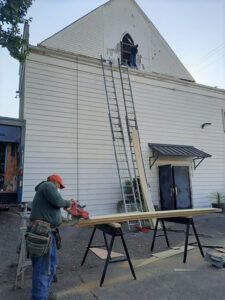
Volunteers are slowly renovating the exterior, as funds are available.
As we address the most pressing issues, we find other problems. As donations come in, we can afford to do more. As members carve out space in their schedules, and find time to lend a hand, work proceeds. Henjyoji Shingon Buddhist Temple does not have a large budget, endowment, nor the fabled imperial support of historical temples in Asia.
As with many temple communities, the COVID-19 pandemic slowed plans for revitalization, but also opened new dharma doors through the internet.
While in-person events inside the building paused during the pandemic, construction projects continued. The pandemic period also provided an opportunity for people to build community cohesion through generosity and perseverance, to keep the temple a place for meditation and the development of wisdom.
The pandemic also required that we evolve to embrace new technologies, with our inability to gather in-person pushing us to migrate to online tools. Unexpectedly, the online migration meant we could offer community to people around North America and the world.
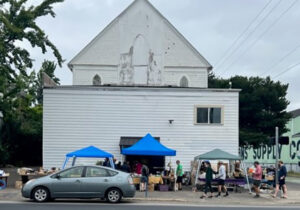
Many people flocked to the summer 2022 tag sale fundraiser.
Because of this, the temple expanded beyond its original ties to a dwindling local Japanese-American community, into reaching out to people all over the world, while re-establishing links within the traditional community. We are happy at the unexpected friendships we’ve made, beyond the borders of Portland, the Pacific Northwest, and the nation.
Core to the temple’s revitalization is Buddhist education. Attend one of the temple’s classes, and you may find yourself in a detailed study of Mahayana Sutras, learning about historic Buddhist figures, or about points of practice.
During the winter practitioners recite the Heart Sutra in the main hall, their breath visible in the chill air. I tell them the experience is similar to that of many temples in Japan, where the main hall is often not insulated or heated. When those people return, I’m encouraged that traditional Buddhist practice can still take root here despite discomfort.
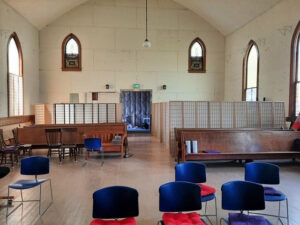
New chairs complement historic pews in the main hall.
Henjyoji Shingon Buddhist Temple opened in the current location in 1951, in a building originally constructed in the late 1890s as a Lutheran church. The temple was a refuge for the Japanese-American community after World War II. The temple’s story over decades is like that of many communities impacted by development, demographic shifts, and the wider world outside its walls.
Shingon, one of the oldest Buddhist traditions in Japan, is sometimes described as “esoteric” Buddhism, or Japanese Vajrayana or Mantrayana. While people generally associate Vajrayana practices with Tibetan Buddhism, in fact Japanese tantric Buddhist lineage predates the 8th century introduction of Buddha’s teaching to Tibet. The traditions that traveled from India, through China, and settled into Japan as Shingon, are the same that eventually made their way into Tibet, and developed into the Tibetan Buddhist lineages we are familiar with today.

Newly gutted kitchen and bathroom space, ready for renewal.
Zen draws its name from the Sanskrit term dhyana, meaning meditation, whereas Shingon is the Japanese pronunciation of the term mantra. Shingon is a Mahayana school with a philosophical focus on mantra practice.
Shingon is quite famous in Japan, with its founder, the Japanese monk Kukai, celebrated both for his religious and secular contributions to Japanese society. Kukai is famous for establishing the monastic complex Koyasan, which is still active deep in the mountains of Wakayama prefecture near Osaka.
Shingon remained largely within Japan until the modern area of regional expansion in Asia, and Japanese people moving abroad. Shingon was introduced to the United States by Japanese farmers and farm laborers, as they moved to Hawaii, California, Oregon, and Washington.
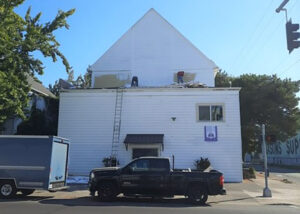
Front view of temple with preparation for siding repairs
The spread of Shingon, and many other Japanese Buddhist lineages, was greatly disrupted by World War II. Prior to the war Shingon temples and practice groups extended as far east as Chicago and New York. The removal of Japanese Americans from cities to rural concentrations camps, was accompanied by a policy of deporting Buddhist teachers back to Japan. Smaller temples and practice groups struggled to reconstitute after the war, resulting in Shingon temples largely remaining along the Pacific rim.
Henjyoji Shingon Buddhist Temple experienced a similar fate, with its teacher and members removed first to the Portland Assembly Center, and eventually to the Minidoka Concentration camp in Idaho. Following the end of WWII and the release of the temple’s founder and members, the community worked to reestablish the temple.
Following the war, the temple became known in Portland for its outreach through a host of cultural and artistic activities such as pottery, a bonsai club, and assistance with establishment of the Portland Japanese Garden. Most notably the temple became known as a center for Ikebana, Japanese flower arranging. While Ikebana is most known for its aesthetic qualities, the tradition was and continues to be, a way for temple members to express the Buddha’s teaching. The temple’s history in the arts and culture is rich, and one we look forward to revitalizing as well.
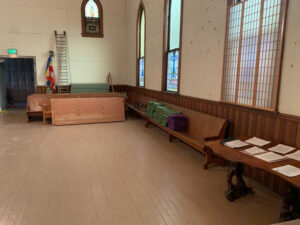
View of the main hall, and 130-year-old windows.
In recent decades the temple experienced a gradual decline with shifts in language, and its member population growing older, smaller, and more dependent on Japanese speakers for survival. By the early 2000s the community was very small, depending almost entirely on Ikebana students for the temple’s continued existence. In 2018 the temple’s board made the momentous decision to open the doors wider and invite a new teacher, a more diverse community, and new ideas for the temple’s continued survival.
The temple would not exist today, and renovations would not be possible, without members giving valuable time and resources to keep the Shingon tradition alive in the Pacific Northwest. This generosity ensures that the temple’s name Henjyoji, meaning “universal illumination,” continues to touch people in many ways.
We invite anyone with an interest in the dharma to visit, in-person or online. Our website includes a description of current classes, and events. We host regular classes focused on the study of Buddhist sutras, and Buddhist history, traditions, and practice.
Those curious about the Shingon tradition are welcome to bring questions. Those interested in the renovations are welcome to bring their curiosity, tools, and helping hands. Revitalization means constructing a community genuinely interested in Shingon, a Buddhist tradition that recently celebrated its 1,200-year anniversary, and with a presence in the United States for more than 110 years.
We look forward to welcoming you and your curiosity, community, and friendship, virtually or in-person. Let us say in advance, please excuse our dust.
Rev. Kosho Finch is the lead teacher at Henjyoji temple. Ordained in the Koyasan Shingon lineage in 2000, he has served temples in the mainland U.S. and Koyasan Shingon Mission of Hawaii. Finch was invited to Portland in 2018 by the members of Henjyoji temple. He has lived in and studied Buddhism in China and Japan.
